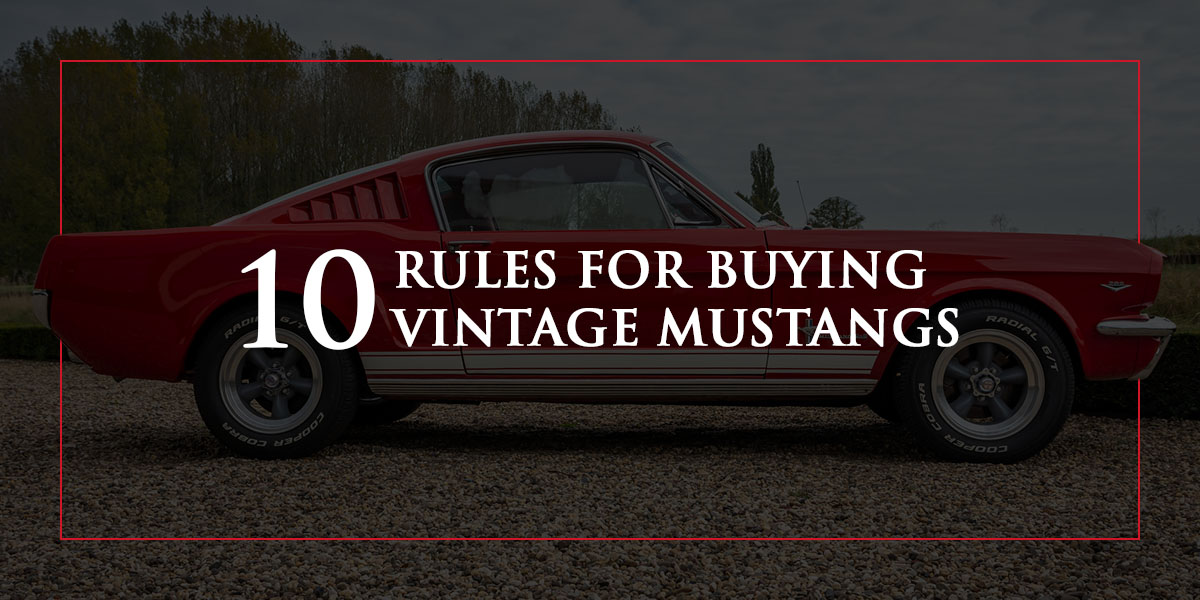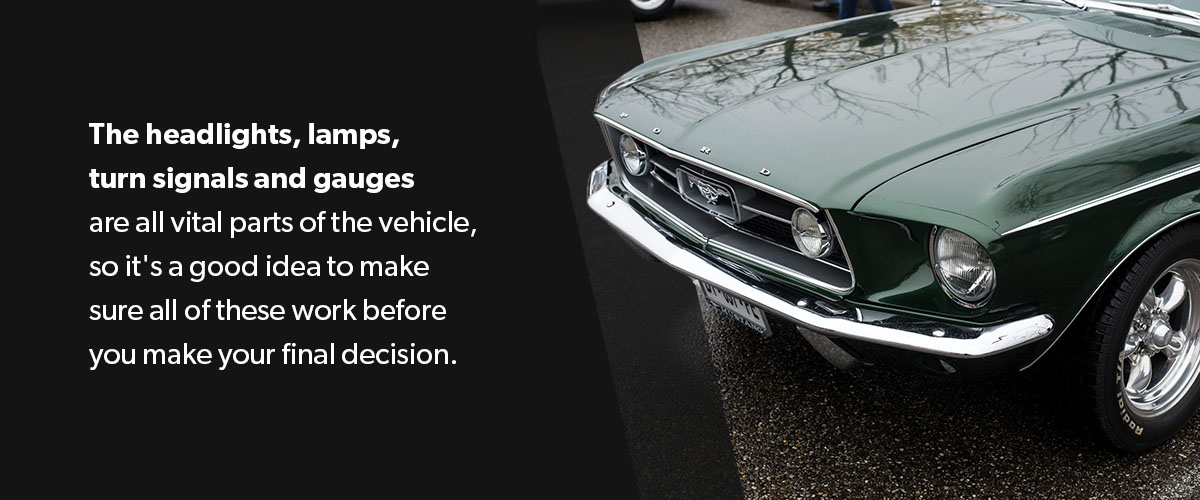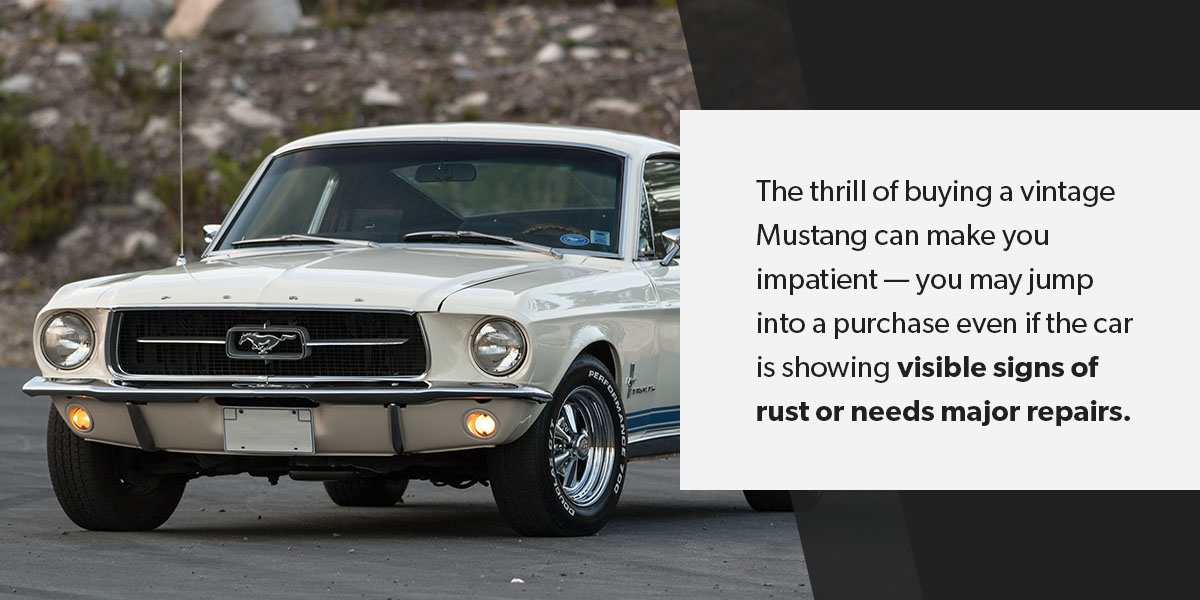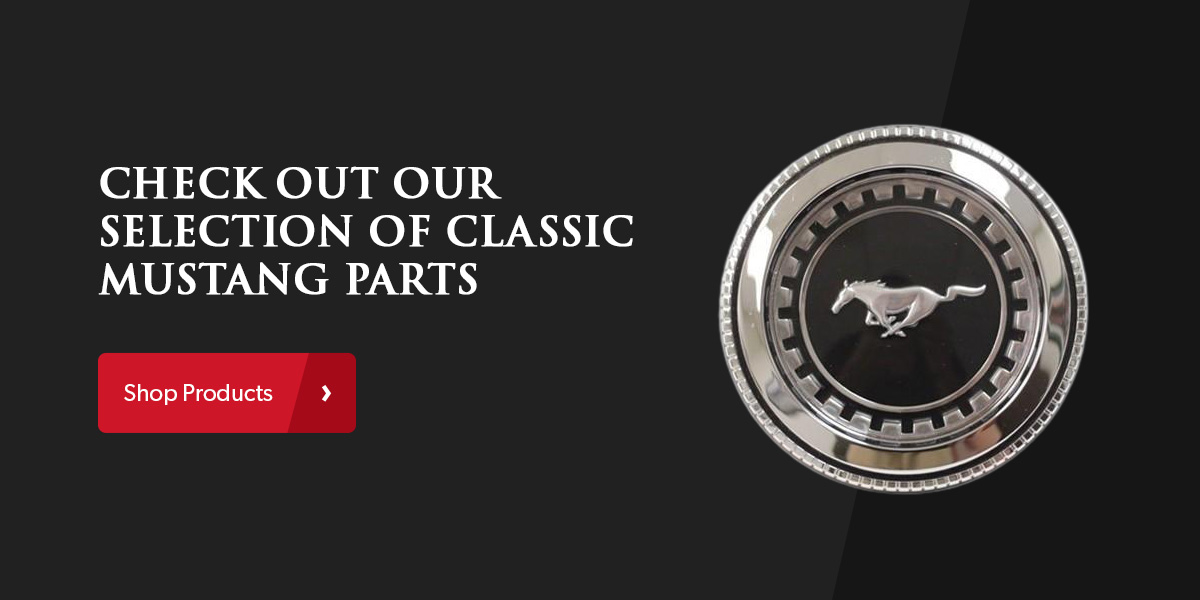
Buying a classic Mustang is an exciting process. The Mustang-inspired generations of pony cars to come after it — owning one of these vehicles is like owning a piece of that vintage past.
With its sturdy frame and impressive performance, the Mustang became vastly popular, showing up in movies and TV shows and becoming a staple of America’s auto history. If you’re looking to buy a Mustang, it’s important to take your time and make sure you’re getting what you pay for.
Here are 10 rules for buying vintage Mustangs to guide you through the process.
1. Identify VIN Number and Door Date Plate
When you go to check out classic Mustangs, you can start by finding the Vehicle Identification Number (VIN). You can find the VIN in a few different places — inside the engine compartment, in the interior where the dashboard meets the windshield or inside the driver door jamb on the door date plate. The VIN provides information about the model year, body style and engine size.
Likewise, a door date plate will tell you the original aspects of a vintage Mustang, such as the exterior color, interior trim, transmission and more. A vintage Mustang will likely go through various overhauls throughout its life, so the door date plate can help you determine just how original it still is.
2. Examine the Exterior
One of the first things you’ll want to do when buying a vintage Mustang is to examine its exterior. Even before you go in person to look at a Mustang, you’ll likely be able to get a good feel for the car just by checking out its appearance in online pictures. On the other hand, a sparkling exterior can look much different when you get up close. The exterior can tell you many things — whether it has rust, how well-kept it is and if it’s been restored recently.
When you look at the Mustang in person, examine the vehicle for scratches or chipping paint. See if the Mustang still has its original body parts — if not, this may mean that the car was in an accident. A simple eye test will let you know if there’s been a questionable repair. Small, minor damages aren’t a huge deal. Just make sure there aren’t any significant body panel issues or damage that will affect the vehicle’s operation or aesthetics.
Before you purchase a classic Ford Mustang, make sure you examine the exterior so that you’re getting what you pay for.
3. Try Out the Electrical System

One thing you may forget while checking out a classic Ford Mustang is its electrical system. The headlights, lamps, turn signals and gauges are all vital parts of the vehicle, so it’s a good idea to make sure all of these work before you make your final decision. In many cases, the electrical systems in vintage Mustangs hold up surprisingly well, so you should be able to find one that’s in working order.
4. Test Operations
It may be tempting to take a quick look and jump to a decision when it comes to vintage Mustang buying. However, you should take your time and test out all the various operations in a car. Turn on lights and open and close doors and windows to see that they’re fully functional.
5. Inspect Engine and Transmission
The engine is arguably one of the most important aspects of vintage cars. It may be challenging to determine what you have under the hood upon a simple inspection. You can talk to the owner to see if they know or check out the VIN for more specific details.
6. Test Brakes and Suspension
Purchasing a classic Ford Mustang comes with a few risks — you aren’t getting the various safety enhancements found in today’s innovative vehicles, for instance. For that reason, you should take extra care to make sure the safety tools you do have are in working order so that you stay protected on the roads.
Make sure the brakes and suspension work efficiently for drivability. In many classic Mustangs, the suspension and brakes will have been upgraded to newer versions. Drum brakes may have been replaced in favor of power disc brakes and air shocks might have been added for a better feel on the roads. Depending on what you’re looking for, you may be okay with these upgrades or want to look for an option with OEM products still intact.
Either way, you’ll want to find out the general quality of the brakes and suspension either through an inspection or a thorough conversation with the owner. With the right information, you can determine if you’ll need to put some work into the vehicle or have faith in its current condition.
7. Make Sure It’s Structurally Sound

While a vintage Mustang may look perfect from the outside, you’ll also want to make sure it is structurally sound. If you can, take a look under the Mustang’s undercarriage with a flashlight. Look for any rust or parts that have replaced the OEM installations. New parts may indicate that the vehicle was in an accident at some point in its past, and rust can pose major issues for the car’s operations.
Check for those structural components when buying a vintage Mustang to gain more confidence in the vehicle’s drivability.
8. Get a Feel for the Inside
Even if the interior isn’t sparkling new, you can still put some work into the upholstery and carpeting to make it look decent again. You should look out for structural issues on the inside that the previous owner might have created, such as holes cut in the doors for speakers or the original radio cut out for modern installation. Depending on what your goals are for the Mustang, you may not mind these changes. It’s something to keep an eye on as you go through the buying journey.
Minor damage such as stained seats or any tears in the upholstery are things to look for as well. These may help you negotiate a lower price, as you’ll likely want to replace those in the future. Sit inside and get a feel for the car — close the doors and also check out the actual scent of the vehicle.
It probably won’t have that new car smell, but you’ll also want it to be relatively neutral. A lot of vintage cars carry their own scents that can be hard to get rid of. If you find a scent overpowering — like smoke or pet smells — make sure you consider this before you buy or map out a strategy to eliminate it before you make your final decision.
9. Drive It
There is no better way to identify a vehicle’s condition than to actually get behind the wheel and drive it. You can inspect the exterior, get inside and even look under the hood, but taking it out for a spin will allow you to get valuable information in the process of buying a classic car.
You’ll be able to get a feel for the comfort of the seats as well as the car’s overall drivability. Does it drive straight? Any strange noises? A thin whistling noise emanating from the door may mean you need some new weatherstrip. You’ll be able to check to see if gauges and turn signals are working and test the effectiveness of the suspension and brakes.
Ultimately, you’ll be test-driving your future purchase, so it’s important to see how the car feels as you drive it and determine whether you could see yourself driving it again. There are likely to be various components you’d like touched up to fit your preferences, and though you may not fall in love during a first drive, you’ll probably be able to tell whether this is a legitimate option for you or whether you should set your sights on a different option.
If a particular seller is uneasy about you testing the vehicle out, this could point to further issues and is often a red flag.
10. Avoid Excessive Rust
While a little rust won’t be detrimental to your vehicle, a lot of it can cause many issues. This is one of the main challenges when it comes to classic car purchasing. Rust eats away at a vehicle’s metal exterior, working its way into the structure and jeopardizing its operations and safety.
After years out in the elements, it’s easy for these cars to wear down and show rust. If you can, try to find a vehicle that’s rust-free. This will make it much easier to restore your vehicle back to its original appearance. For every Mustang you look at, make sure you’re examining areas for rust.
Finding a Mustang that’s free of rust will give you confidence that your car is in great shape — both in operation and in its exterior appearance.
Additional Vintage Mustang Tips
A simple set of rules will put some helpful parameters around your vintage Mustang buying journey. As you examine the vehicle and consider your options, keep in mind these additional tips.
Get Your Worth
You want to make sure you’re getting what you’re paying for. Buying a vintage Mustang can be challenging because there are so many parts and operations to test out. If you want, you can ask the owner if you can have a professional inspection done to give you more confidence about the vehicle. If the owner declines, you may want to go to a different seller.
You’ll want to find a car that you can admire and drive for years to come, so be aware of the amount you’re paying and make sure it lines up with the quality of the vehicle.
Be Patient

The thrill of buying a vintage Mustang can make you impatient — you may jump into a purchase even if the car is showing visible signs of rust or needs major repairs. During the buying process, it’s important to stay patient and methodical. Examine each aspect of the vehicle thoroughly and ask the seller any lingering questions you may have about the car. Taking that extra time may uncover new information about the vehicle that could impact your final decision.
Be sure to check out various options as well so you can get a better feel for the market and weigh the price and quality of one vintage Mustang against another.
Consider the Scope of Work
Even before you start examining these vintage Mustangs, it will help to outline the amount of work you’re willing to put into the car. Are you willing to make this a full-fledged restoration project, or are you looking for a Mustang that’s ready to drive as-is?
If you’re hungry for a full do-it-yourself project, you’ll probably be able to find a more affordable Mustang that requires a lot of work. A more complete and already-restored Mustang may be priced a bit higher. It will help to define how much time and energy you’re looking to put into the car so that you know what you’re looking for throughout the buying process.
Find the Right Seller
Purchasing a vintage Mustang can be challenging. Finding the right seller will make the process go a little smoother. A local seller will be beneficial since you’ll be able to check out the car in person. Try to find sellers that provide you with a wealth of information about the vehicle, including details about its history and any repairs it may have had. The more information the seller provides you with, the more confident they likely are in its operations.
Check online, visit your local dealership and talk to neighbors and friends so you can expand your search and find as many options as you can. Once you find some vintage Mustangs you like, be sure to check out these classic Mustang tips and rules to help you through the process.
Choosing Top Flight Automotive for Vintage Mustang Parts
After you’ve finished buying a classic Ford Mustang, you may be looking for a trusted dealer that can provide you with classic Mustang parts. Top Flight Automotive offers a vast selection of in-stock inventory to help you with your restoration projects. Quality parts can be hard to find — Top Flight Automotive solves that issue by providing all the quality parts you need in one convenient place.
Browse our selection of Mustang parts and talk to our experienced sales representatives to answer any questions you may have. You no longer have to jump from seller to seller looking for individual parts because Top Flight Automotive carries everything required to make your restoration process efficient and successful. Our loyalty program works great with restoration projects, since the more products you buy, the larger your discount will be.
Whether you’re looking for interior upholstery, exterior parts or engine components, Top Flight Automotive has what you need.
Shop Online Today
Even more exciting than shopping for a classic Mustang is owning one! You can undertake a restoration project to make your vehicle shine, improve its drivability and return it to its beloved vintage state. Visit Top Flight Automotive to check out our selection of classic Mustang parts or talk with our sales team to find what you need.











September 12th, 2023 at 9:37 am (#)
Great article 👏 Have owned several Mustangs, from Fastbacks, Coupes, and a Convertible over my lifetime. And have had emence joy in owning, driving and learning to fix and restore them to show quality with the great wealth of available parts to keep them on the roads…
Stay Fordified,
Mustang Mike
April 1st, 2024 at 8:51 pm (#)
Finally just bought our 1st! Promised my wife a ‘66 about 44 years ago when we were 18 & 19 yo! Still together having raised children and grandchildren!
We just bought a 65 in pretty good shape! I didn’t really do my homework 1st, but my son-in-law and his dad were an enormous help! This one is red exterior and red interior, but it has a color code of M for white. it’s pretty much all OEM, so I need to decide to stay that path or make it more fun to drive. I look forward to chatting about it and learning about restoring, maintaining and loving this vintage classic!
February 25th, 2025 at 8:35 am (#)
Thanks for all the insights of checking a vintage Mustang when purchasing one. Your information was easy to understand and felt genuine. I believe your information will help me buying my first vintage Mustang. Thanks again guys!